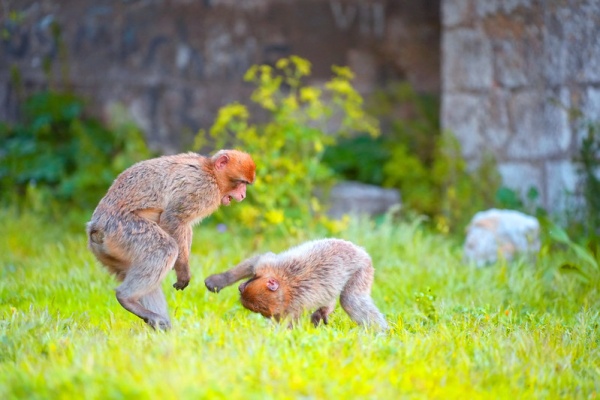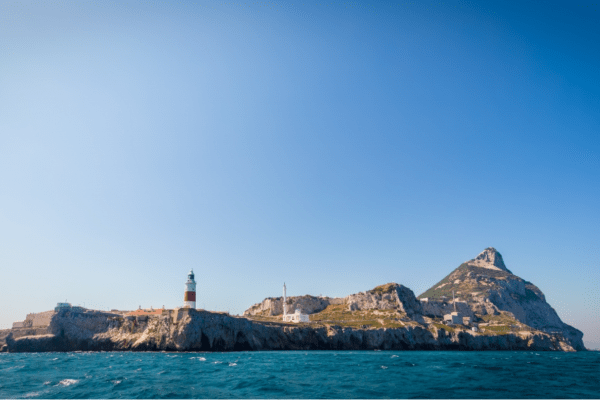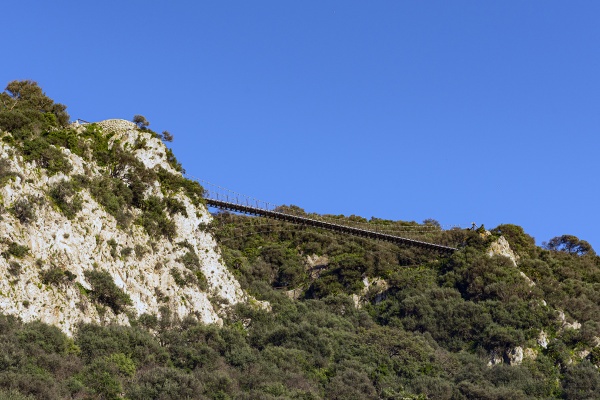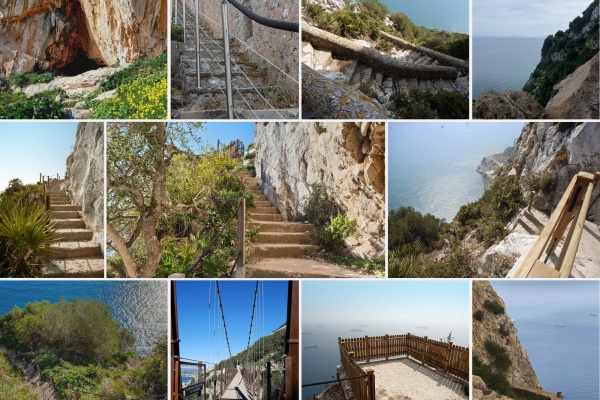
The Barbary Apes of Gibraltar © VisitGibraltar.gi |
|
Natural history of Gibraltar
Gibraltar, a limestone promontory rising at the southern tip of the Iberian Peninsula, is a remarkable meeting point between Europe and Africa — where Mediterranean and Atlantic ecosystems blend. Despite its small size, Gibraltar is home to an impressive diversity of wildlife, both terrestrial and marine.
The Rock of Gibraltar is a giant slab of jagged Jurassic limestone. It has dominated the Straits of Gibraltar for around 200 million years and of course over such a period has continually changed and evolved. The porous limestone ensures that the Rock always has a plentiful water supply. So when nearby Spain is often arid and brown the Rock will be lush and green.
At one time the rock was covered in natural woodland. Soldiers and others cleared this in search of firewood. Today, the upper reaches are essentially green again covered with shrubs and trees such as nettle trees, carob, eucalyptus and wild olives. There are also a wide variety of wild flowers including Gibraltar's own Candytuft and Chickweed.
In the past red deer, wolves and wild boar would have made their homes on the Rock. They may have disappeared but the teeming bird life goes on with over 200 species having been recorded. Many of these are migratory birds whose habits have been unchanged by time.
Gibraltar’s natural heritage is a microcosm of Mediterranean biodiversity — a place where ancient limestone cliffs, vibrant marine life, and migrating birds all converge. Whether watching dolphins from the bay, exploring the botanical gardens, or meeting the famous macaques on a guided tour, the Rock offers an unforgettable window into nature’s resilience and diversity.
The Barbary Apes
Perhaps the most famous residents of Gibraltar are the Barbary macaques, the only wild monkeys in Europe. These intelligent primates roam freely on the Upper Rock, especially around the Apes’ Den and the Great Siege Tunnels. Their presence is steeped in legend — it is said that as long as the apes remain, Gibraltar will stay British. Today, the population is carefully managed to ensure their health and the balance of their habitat. More>
Tours of the Rock
Exploring Gibraltar’s natural treasures is easy thanks to the variety of guided tours of the Rock available. Local guides offer half-day and full-day excursions that include visits to the Upper Rock Nature Reserve, the Apes’ Den, St. Michael’s Cave, and panoramic viewpoints overlooking two continents. Specialised tours for birdwatching botany, and marine life observation are also available, offering visitors a deeper understanding of the Rock’s remarkable biodiversity. More>
Dolphins & Whales
The waters surrounding Gibraltar are teeming with marine life. Several species of dolphins — including the common, striped, Risso's and bottlenose dolphins — can be seen year-round in the Bay of Gibraltar. Occasionally, migrating whales, such as pilot whales and even orcas, can be spotted passing through the Strait, making the area a hotspot for marine observation and eco-tourism. More>
Bird Watching
Gibraltar lies on one of the world’s great migratory routes, serving as a vital stopover for birds crossing between Europe and Africa. Each spring and autumn, thousands of raptors, swallows, and songbirds fill the skies. More>
The Botanical Gardens
The beautiful Alameda Gardens were first opened in 1816. Around the gardens are a number of commemorative busts and cannons dating from the 19th century. Chief attraction are the splendid plants and trees some of which are native to the Rock whilst others have been imported. The Gardens are open from 0800 to dusk daily. Admission is free.
The gardens provide a tranquil retreat for visitors and serve as an educational and conservation hub for Gibraltar’s unique flora. More>
For more information on the Gibraltar Botanic Gardens, talks, events and tours of the gardens contact:
Tel: +350 20072639 - Email; [email protected]
Alameda Wildlife Conservation Park
Within the Botanic Gardens, the Alameda Wildlife Conservation Park offers refuge to rescued animals and endangered species. This small but vital sanctuary participates in international breeding programs and raises awareness about wildlife conservation. Visitors can encounter lemurs, tortoises, reptiles, and birds in a carefully maintained natural setting. More>
Upper Rock Nature Reserve in Gibraltar
A visit to Gibraltar’s Upper Rock Nature Reserve is an absolute must during your stay. This iconic area offers a unique blend of natural beauty, panoramic views, and centuries of fascinating history. For tours see our self-guided options or alternative taxi tours
Key attractions include:
- Charles V Wall
- Moorish Castle
- Great Siege Tunnels
- WWII Tunnels
- St Michael’s Cave
- Historic gun batteries, including Princess Caroline’s and O’Hara’s
- The Windsor Suspension Bridge







